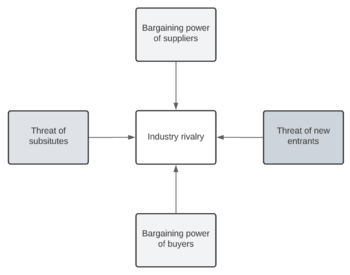Porter's Five Forces Framework
From DTU ProjectLab
(Difference between revisions)
(→Abstract) |
|||
| Line 2: | Line 2: | ||
[[File:PorterFiveForces.png|350px|thumb|right|'''Figure 1''': Porter's Five Forces Framework. Own creation based on Porter's Five Forces publication. <ref name="R1" />]] | [[File:PorterFiveForces.png|350px|thumb|right|'''Figure 1''': Porter's Five Forces Framework. Own creation based on Porter's Five Forces publication. <ref name="R1" />]] | ||
| − | The competitive forces model, better known as Porter’s Five Forces, is a method used in industrial economics (IO) for analysing the competition in the operating environment of a company. Porter’s Five Forces Framework was published in Harvard Business Review by Michael E. Porter of Harvard University in 1979. <ref name="R1" /> Porter developed the model in response to the widely used SWOT analysis, which was considered too rigor and ad hoc. The framework consists of five fundamental powers that drive industry competition, namely: bargaining power of suppliers, bargaining power of buyers, threat of substitutes and complementary goods, threat of new entrants to the market, and internal market competition. <ref name="R1" /> Three forces represent 'horizontal' competition: threat of substitutes and complementary goods, threat of new entrants to the market, and internal market competition. Vertical competition is represented by the bargaining power of both suppliers and buyers. | + | The competitive forces model, better known as Porter’s Five Forces, is a method used in industrial economics (IO) for analysing the competition in the operating environment of a company. Porter’s Five Forces Framework was published in Harvard Business Review by Michael E. Porter of Harvard University in 1979. <ref name="R1" /> Porter developed the model in response to the widely used SWOT analysis, which was considered too rigor and ad hoc. <ref name="R2"> The framework consists of five fundamental powers that drive industry competition, namely: bargaining power of suppliers, bargaining power of buyers, threat of substitutes and complementary goods, threat of new entrants to the market, and internal market competition. <ref name="R1" /> Three forces represent 'horizontal' competition: threat of substitutes and complementary goods, threat of new entrants to the market, and internal market competition. Vertical competition is represented by the bargaining power of both suppliers and buyers. |
The five competitive forces can be assessed to determine the profitability potential of markets and industries for a company. Analysing Porter’s Five Forces can be of great value to companies for exploring and examining market entry opportunities, with regards to expanding and evaluating a project portfolio – for example, in the field of product and service development. By assessing the risk of industries, managers can make strategic decisions with regards to current and future projects in the company portfolio. | The five competitive forces can be assessed to determine the profitability potential of markets and industries for a company. Analysing Porter’s Five Forces can be of great value to companies for exploring and examining market entry opportunities, with regards to expanding and evaluating a project portfolio – for example, in the field of product and service development. By assessing the risk of industries, managers can make strategic decisions with regards to current and future projects in the company portfolio. | ||
| Line 36: | Line 36: | ||
<references> | <references> | ||
| − | <ref name="R1"> | + | <ref name="R1"> Porter, M.E. (1979). How Competitive Forces Shape Strategy. ''Harvard Business Review 57''(2), 137–145. </ref> |
| + | <ref name="R2"> Porter, M.E, Argyres, N., & McGahan, A. M. (2002). An Interview with Michael Porter. ''The Academy of Management Executive (1993-2005), 16''(2), 43–52. </ref> | ||
| + | |||
[[Category: Competitive Analysis]] [[Category: Project Management]] | [[Category: Competitive Analysis]] [[Category: Project Management]] | ||
Revision as of 12:07, 10 February 2022
Abstract

Figure 1: Porter's Five Forces Framework. Own creation based on Porter's Five Forces publication. [1]
The competitive forces model, better known as Porter’s Five Forces, is a method used in industrial economics (IO) for analysing the competition in the operating environment of a company. Porter’s Five Forces Framework was published in Harvard Business Review by Michael E. Porter of Harvard University in 1979. [1] Porter developed the model in response to the widely used SWOT analysis, which was considered too rigor and ad hoc. Cite error: Closing </ref> missing for <ref> tag [2]
Cite error:
<ref> tags exist, but no <references/> tag was found